On This Day…June 2nd.
Hampden TB.1 (AD852) UB-N - of 455 Squadron, RAAF Leuchars, Scotland, 2nd June 1943. Great angle to see that distinctive Hampden shape.
And above, same aircraft and day, in flight.
On June 2nd, 1943, one of the most astonishing examples of bravery, determination, and skill played out over the Bay of Biscay. The RAF were increasingly spread thin in their attempts to hunt down the U-Boat threat across the Atlantic, North Sea, and English Channel. One of the most rewarding hunting grounds was the Bay of Biscay (below) where the German submarines would put out for patrol or return from tours.
On a sortie over the Bay for 461 Squadron, a Short Sunderland (N461) manned by nine Australians and two RAF crew took on eight Luftwaffe Ju88. The story is taken up by Ivan Southall of the 641st...
‘1855 hours. The turrets moved slowly while eyes strained in the sunlight. This was indeed the Tiger Country; a slaughteryard, a stage for a play of suspense and savagery, where all men at one time or another knew the meaning of fear. Here there were no parachutes and no patriots in the back country.'
‘1900 hours. Goode, swinging his tail turret to the right, suddenly stopped. His eyes widened and his heart missed a beat:
“Tail to Control,” he barked.“Eight aircraft. Thirty degrees on the port quarter. Six miles. Up one thousand feet.”
‘Pause. Electric silence.'
‘A moment or two of shock. Simpson suddenly jumped to the astrodome. Walker
rammed his throttles wide and sounded the alarm. Dowling hauled on the pitch levers and the engines howled at twenty-six hundred revolutions a minute.'
“Control to Tail. Can you identify those aircraft?”
“Twin-engined,” said Goode. “Probably Junkers 88's.”
They were. They came sweeping in at high speed.
“Captain to Wireless Operator.” Walker's voice was sharp and urgent.
“Message to Group. O/A Priority. Attacked by eight JU-88s . . . . How's that inner engine, Engineer?”
“No worse, Captain. No better.”
“Captain to Galley. Have you got the bomb-racks out?”
“Ready, Captain.”
“Right. Bombs gone. You've got to work fast. Run in the racks, close the doors, and get cracking with the galley guns. Who's down there to man them?”
“Miles on the starboard, sir. Lane on the port.”
“Control to all positions.” That was Simpson again. “They've spread all round us. Hold your fire until they're in range. Don't shoot before six hundred yards.
Three are on the Starboard beam; three port beam; one on each quarter. Range fifteen hundred yards; fifteen hundred feet up.”
‘Simpson paused and they all waited. Suddenly his voice was there again, precise, calm, yet...underlaid with urgency.'
“Okay. They're coming. One peeling off from each beam. Prepare to corkscrew. Twelve hundred yards. One thousand yards. They're firing. Prepare to corkscrew to starboard. Eight hundred yards. Corkscrew starboard. Go!”
“Walker jammed over the wheel with a violent thrust of strength. The Sunderland screwed steeply down. Shell and tracer blasted right through it. “Corkscrew port. Port. Now port. Go!”
‘Walker savagely reversed controls. The boat shuddered with shock and climbed giddily to the left. The port-outer engine burst into flames. Smoke and fire scattered over the wing. Incendiary bullets ripped up the cockpit. Walkers compass blew up and sprayed him with blazing alcohol. Liquid fire splashed across the bridge and poured down the companionway into the bow compartment.'
‘Through a confusion of sound and vibration and choking smoke Walker heard Simpson urging him to straighten up. But two more 88's were on the way in. They had blooded. They had scored in the first attack. They were screaming in for the kill. Walker yelled at Dowling, “Take over! Fly it! We've got to get these fires out!”
Amiss wrenched the extinguisher from its bracket on the bulkhead and turned it full onto the captain, because Walker was burning. Simpson's calm voice still was coming through the earphones, “Eight hundred yards,” he was saying. “Corkscrew port . . . Corkscrew port . . . .”
‘And Walker was hearing it but seeing nothing, only smelling the smoke and the extinguishing fluid, and now the Sunderland was plunging down again and Dowling was fighting the controls. Amiss, hanging on his extinguisher and clinging for support to anything he could hold, was chasing the fires. Walker pressed the Graviner switch to extinguish the blazing engine. The fire snuffed out into clouds of white smoke which the aircraft left behind it as a billowing trail. The engine was finished. The airscrews windmilled and dragged and Dowling was up against it. Walker swung on Amiss again, “Give the wireless operator a message for Group, On Fire.”
‘The 88's were still coming in, again and again. They pressed home their attacks with increasing fury and reckless courage and Dowling could scarcely hold his aircraft. It was pulling like a mad thing to port into the dead engine. He wound the trimming tabs over as fast as his hand could fly, but it still didn't take up the pressure; he still had full weight jammed against the rudder pedal to hold it in control. Simpson's voice suddenly dropped in pitch.
“They're reforming. They've returned to the quarters and the beams.”
There was a pause, a breather for a few seconds. Amiss overcame the fires on the bridge and Walker again took the controls. There was a brief silence on the intercom. They were in terrible trouble, and there wasn't a man aboard who tried to deceive himself into believing that they weren't. Suddenly a new voice came over the intercom. It was Fuller in the midships turret, up there on top in the weakening sunlight. He was singing:
“Praise the Lord and pass the ammunition, Praise the Lord and pass the ammunition.”
“They're coming,” said Simpson. “One from port and one from starboard.
———The next section reads from official archives, reports, and witness statements ———
‘Within the first 15 minutes of the action 2 JU88's were seen to crash into the sea, both in flames - the first, which was shot down by the mid-upper gunner after passing over him at 100' dived straight in and disintegrated, and the second, shot down by the tail gunner and possibly aided by the mid upper gunner, checked his dive at the last minute, hit the sea, bounced, stalled and dived in, also disintegrating.'
‘The 88's, which had formed up on quarters, came in climbing attacks but these were checked by our port and starboard galley gunners, and must have come as a nasty surprise to them as our aircraft was only the second to be fitted with these guns which were used in action for the first time on this occasion.'
‘The base of the rear turret now received a direct hit by a cannon shell and became jammed, the hydraulics being shot away. At the same instant violent evasive action was taken and the tail gunner was knocked unconscious for about 5 minutes.'
‘Shortly after, another hit by a cannon shell freed the turret which was operated by hand from now on with only 2 guns serviceable, the gunner extracting the securing pins, elevating and depressing the gun, rotating the turret and depressing the sears by hand. The same shells severed both elevator and rudder trimming controls and with the port engine lost it took both the Captain and the 1st pilot their combined strengths to control the aircraft in the violent evasive action taken.'
‘At 19.25 hours the Captain asked that the following message be transmitted "2 88's shot down". At 19.30 the wireless received a direct hit from a cannon shell and both transmitter and receiver became U/S. Back at our base they received only the first word of this message then heard our transmission fade out and were therefor forced to assume (after hearing nothing for three and a half hours) that we had been shot down in flames. We later learnt the 2 aircraft were diverted immediately to our last known position to look for our survivors if any.'
‘Shrapnel from the cannon shell which wrecked the wireless also wounded the navigator in the leg, passing right through his calf, caused cuts from the broken glass about the face of the wireless operator, punctured one of our dinghies and caused a small cut under the eye of one of our pigeons which had its head stuck out inquisitively from its container.'
‘About this time the starboard galley gunner was fatally wounded, became unconscious and died approximately 20 minutes later: his gun being manned by the other engineer. The navigator did not mention his wound until towards the end of the action when it was attended to while he continued his job in the dome, by which time he had lost a considerable amount of blood. Despite his wounds he carried on as fire controller in a magnificent way and was never flurried in spite of the complexity and number of attacks.'
‘A third 88 was now seen to crash in flames by the navigator and tail gunner; this one being shot down by the nose and mid-upper gunner. The engagement now became completely chaotic, the continuous evasive action and the firing being controlled by the navigator.'
‘The aircraft was hit repeatedly and became filled with the smell of cordite, bursting cannon shells, fire extinguisher chemicals and the strong oder of de-icing fluid from the tank which had been hit. The 88's continued to attack from the beam and bow, reforming for another attack immediately after breaking away from the previous one.'
‘At about 19.35 the intercom received a direct hit and the gunners, realising their fire control had gone, fired independently as the opportunity offered. The navigator continued to give his evasive actions by hand signals passed to the 2nd pilot and thence to the Captain. With his hand signals, the navigator looked more like an orchestra conductor than a fire controller.'
‘At about 19.40 the nose gunner fired a short burst at a 88 attacking from 70' on the starboard bow and his port engine immediately burst into a mass of flames with smoke pouring from the cockpit. This one was not seen to crash. At this stage the Captain realised his airspeed had been shot away for some time and each time he glanced at the A.S.I. he thought the indicator read 145 knots whereas it had actually been reading Zero (145 knots being a complete revolution of the indicator from Zero)'
‘At 19.45 there were only 2 88's left and although one came in to attack on the starboard beam he broke off at 1500 yds, and they were not seen again. We continued our evasive action, making use of what little cloud there was, until 20.00 hours when we set course 030°C.'
‘The action lasted 45 minutes during which time it is estimated we were attacked at least 40 times. Having formed up on both beams the 88's attacked alternately from port and starboard, the attacks being continuous for 45 minutes and the aircraft never being straight and level for more than 15 seconds.'
‘The weakness of the 88's lay in their poor range estimation and very weak break away. Several times they opened fire at 200 yds. often at 1500 yds. and endeavoured to correct their aim by ‘hosepiping'. The mid-upper gunner (19 year old Sgt. Fuller) held his fire until they were about 250 yds. away then let them have it point blank. His coolness and straight shooting were remarkable and the 88's “couldn't attack often enough” for him.'
‘He was singing "Praise the Lord and pass the ammunition" and shouting "Come on you bastards, come and get it". He must have a charmed life as the hull round his turret received dozens of hits.'
‘The nose gunner also did excellent work and it is considered every 88 which attacked received hits as it was almost impossible to miss at the close range.'
‘It is estimated that N/461 had at least 400 holes in her after the action and had been hit about 12 times by cannon shells. After the action it was found that owing to the extremely coarse use of controls necessary for evasion, the whole airframe was twisted; doors which were shut couldn't be opened and vice versa.'
‘After an hour's hectic weaving round the sky with our main compass in bits and the directional gyre useless owing to precision and toppling, we had only the vaguest idea of our position. Until things got sorted out we therefore set course at 20.00 hours on 030°C, with no airspeed, only 3 engines, and using the P 8 compass which we didn't trust, and the navigator took a sun shot.'
‘At 20.30 hours we altered course to 065°C for Land's End with an ETA of 22.24. The Captain now had the crew jettisoning everything possible and our personal belongings, flying clothing, batteries, tool kits, anchor and chain and U/S equipment was thrown overboard; the engineer going through from nose to tail chopping out all useless gear with a fire axe.'
‘We must have jettisoned about a ton of equipment. About 20.30 we sighted another Sunderland 8 miles away but, although we signalled for assistance on the Adis, he apparently didn't see us. The flight engineer reported that the same cannon shell which wounded the navigator had put his port petrol gauge out of order with the balance cocks open we therefore could only assume the port tank held the same as the starboard ones.'
‘The 300 odd mile trip home was uneventful (fortunately) but it took the combined strengths of 2 pilots to keep the aircraft on course. At 22.28 hours the south coast of England was sighted and recognised as Lizard. We then flew along the coast towards Land's End flashing SOS visually on the dinghy transmitter.'
‘As it was now last light and getting dark quickly, the Captain decided to land in the channel just off a sandy beach and in the lee of the wind which was N.W. On the approach to land the starboard outer engine stopped as soon as it was throttled back and the alighting was done on the 2 inner engines in a 7 ft. sea without any airspeed. The alighting was perfect and the crew promptly climbed out on the wing, inflated the dinghies except the U/S one and prepared to ditch.'
——- Local villagers gathered up the crew and treated them as royalty while awaiting pickup.
F/O Dowling, P/O Amiss, F/Lt Simpson, Sgt Turner, Sgt Fuller, Fl/Sgt Miller, Fl/Sgt Lane, Fl/Sgt Goode and Sgt Watson were all back to operational flying from the 8 July 1943 and completed a further 4 operational flights.
On 13 August 1934 all were killed in action while on an Anti-Submarine Patrol in the Bay of Biscay. A signal was received stating the aircraft was being attacked by 6 JU 88's.
It is believed that the aircraft was shot down by a JU 88 and crashed into the Bay. The Sunderland was was claimed by Lt. Artur Schroeder of 13/KG 40.
Winston Churchill stands on top of a captured German Tiger Mk. VI in Tunis, 2nd of June, 1943.
USS Long Island (CV-1) moored a5 Naval Air Station North Island, California. June 2nd, 1942.
Casablanca-class escort carrier USS Guadalcanal alongside captured U-505, June 1944
British troops inspect a line-up of captured German and Italian tanks and other armoured vehicles, Italy, 2nd of June, 1944.
Gia Dinh province, South Vietnam, June 2nd, 1968.
FW 190 A2 of Karl Nowak, 9./JG2 on June 1942.
USS Newell (DE-322) at anchor, New York Harbour, on June 2nd, 1944.
The first 'shuttle' mission to the USSR (for reloading, fuelling under ‘Operation Frantic') was flown on 2 June 1944 by the Fifteenth Air Force with 130 B-17s and a Mustang escort. The target was Debrecen and after bombing, the Fortresses continued on to land in the Ukraine. Russian officers were present at Poltava as the 97th Bomb Group's contingent landed. The B-17G about to touch down is 2102918, I***t's Delight, of the 342nd Bomb Squadron. She fell to flak at Munich on 19 July 1944.
Continued preparations for D-Day; in Lough Neagh, Northern Ireland, vehicles are waterproofed and tested.
USS PC-565 sank German (Type IXC) U-boat, U-521, in the North Atlantic, north-east of Norfolk, Virginia, on June 2, 1943. The only survivor was the Captain, Lieutenant Commander Klaus Heinz Bargsten. U-521 sank four Allied vessels during World War II.
Nice image of F6F-3 Hellcat (VF 2) aboard The USS Hornet in the Marianas, June 1944.
Addendum. I was looking for an iModeler Short Sunderland and I found this with 5 minutes to spare and still say it was ‘On This Day...' A gorgeous aircraft, José, and a lovely tribute to the Coastal Command...






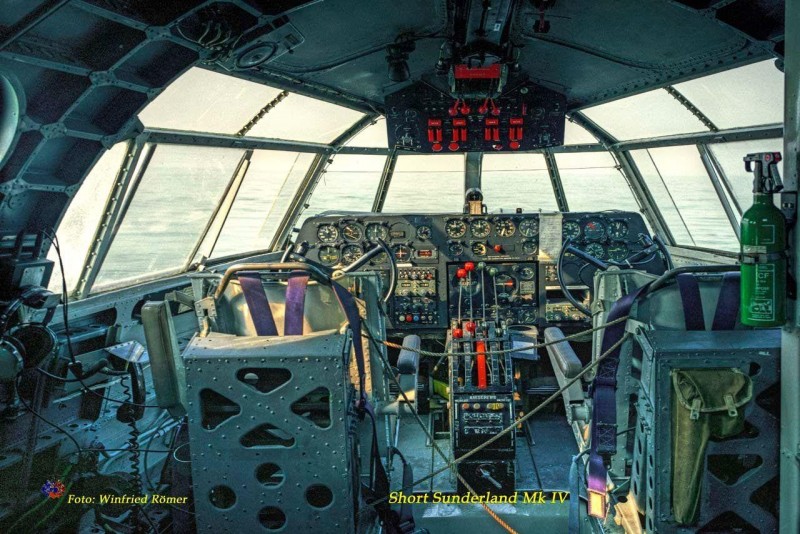














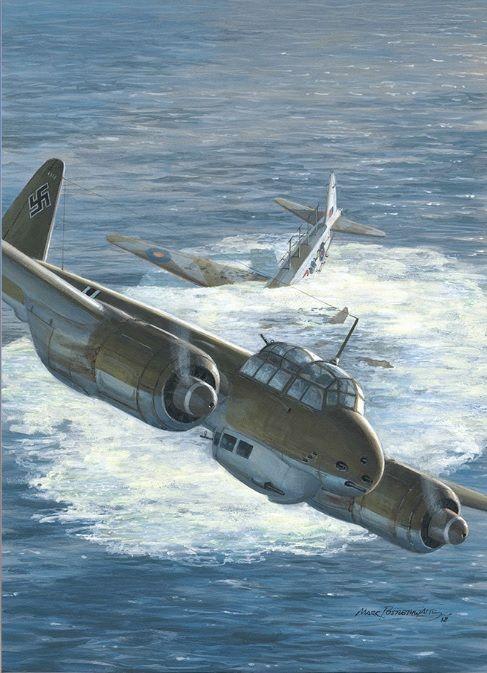

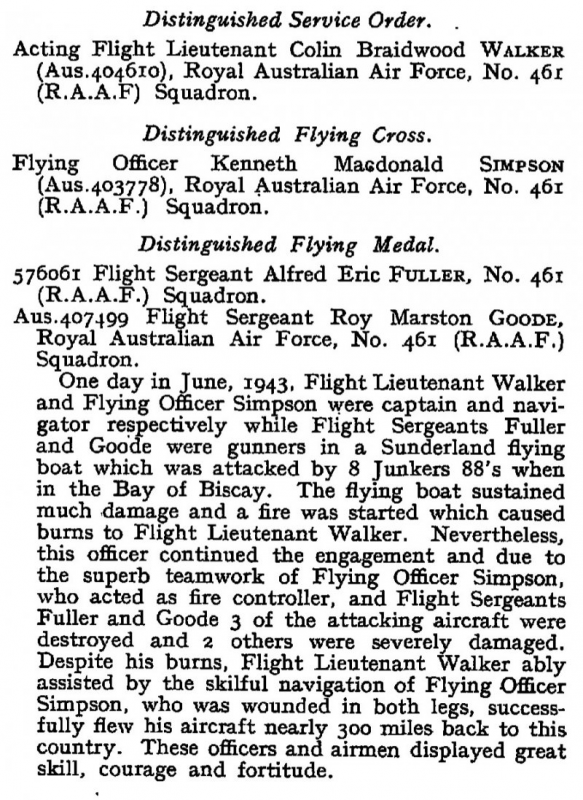












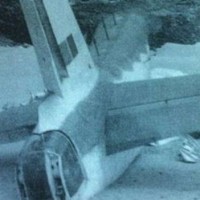



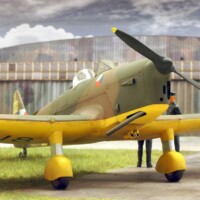
The Sunderland story is utterly remarkable; thanks for sharing it, David. The service you provide with the whole 'On This Day...' project - which is clearly an enormous amount of work - is really valuable; you bring history, context and a conscience to iModeller.
Thank you, Tim. Those words, “you bring history, context and a conscience to iModeller” are a great compliment and sum up exactly what I’d hoped this thread could achieve. Much appreciated.
@timtozer231
David, @dirtylittlefokker
What an amazing story behind the Ju-88's and the Sunderland crew. Your story telling skills kept me at the edge of my seat during the entire read. It played out in my mind like a horror film, but sadly it was based on a real event. Should you ever decide to hang up your doctor's coat, you may have found your second calling as a writer.
I have been inside Kermit Weeks' Sunderland. Let me just say that it is a HUGE flying boat. Here are a few pictures to show the immense size of the Sunderland. Notice how tiny the car looks parked in front of it ...
Here's a Tiger Moth parked "Under" the rear step of the hull ...
and a few other planes parked nearby as well...to use as a judgment for scale of it's sheer size.
The Ju-88 isn't a tiny plane by any means either...One can only imagine the superhuman strength it must have taken to toss them around like a fighter...
Fighting to the death over a barren desolate open sea, with very little if any chance of survival should they crash into the water.
God bless these men. On both sides.
Sad to hear the crew of the Sunderland met their fate in a similar fashion as you described above. But that is war...However, I'm sure they put up a heroic defense this time as well.
I'm constantly looking forward to seeing the collection of various photos you post, and reading the associated stories behind the men and machines. It is like "Christmas" for me each day. You always bring a smile to my face and I learn something new as well. Occasionally you encourage me for a future project. Just recently I took the bait and started a "Judas Goat" B-24 assembly ship.
https://imodeler.com/groups/teeth-fangs-gb/forum/topic/1-48-scale-monogram-b-24-j-tubarao-assembly-ship/
I'm sure that you have inspired others as well.
Each new daily article is like a Christmas gift, and you never know what's inside until you open it up.
'liked"
That’s a hell f a project, Louis. She is a definite eye catcher and is a nice unique build that’ll look amazing.
There’s a Short Sunderland here at the RAF museum, she’s a real monster in terms of size. In the London ship, they allow you to crawl around and stuff inside, it’s just huge.
Thank you (again) for all the support. Means a bunch.
What a story!
Said L.G. - "God bless these men. On both sides." Yes, indeed!
Hell of a story, Jeff, as they say, you couldn’t make it up.
Wow , the Sunderland story was so inspiring Dave, when I was a kid I loved Commando books ,I bet you did as well, my favourite was about a Sunderland crew in the back room of a pub (I think it was a reunion night )drinking and re-telling the story of them coming back shot to pieces after surviving overwhelming odds and then at the end we find that there's no-one in the room and that the pub landlord has been setting the table every year on the anniversary of them being shot down, I have looked and looked for this one but never got another copy, I wonder if it was based on this story.
The Hampden pictures are great too ,one of my favourite WW2 aircraft, I can't wait for Airfix to release the new 1/48...
N.
Now you got me hooked, Neil - I’ve been trying every combination of searches to find that story; sounds right up my street.
Thanks!
Try air ace picture library-fleetwood publications-you may find it there.
That's some story about the Sunderland! Nice shot of the Long Island, not the fist time it appeared here.
Yes, the Long Island is a regular in these parts. Thanks for the comments, Robert.
@roofrat
Great stuff, David. I join the others regarding that Sunderland story.
Thanks, Tom, the Sunderland episode is a story for the ages.
Wow... "just" wow!
Incredible story on the Sunderland; a "page turner."
I too especially love the stories you find - such as the Sunderland and the prior one about the French Foreign Legion woman (found her book on Amazon). Personal stories/bios are one of my favorite perspectives of any war.